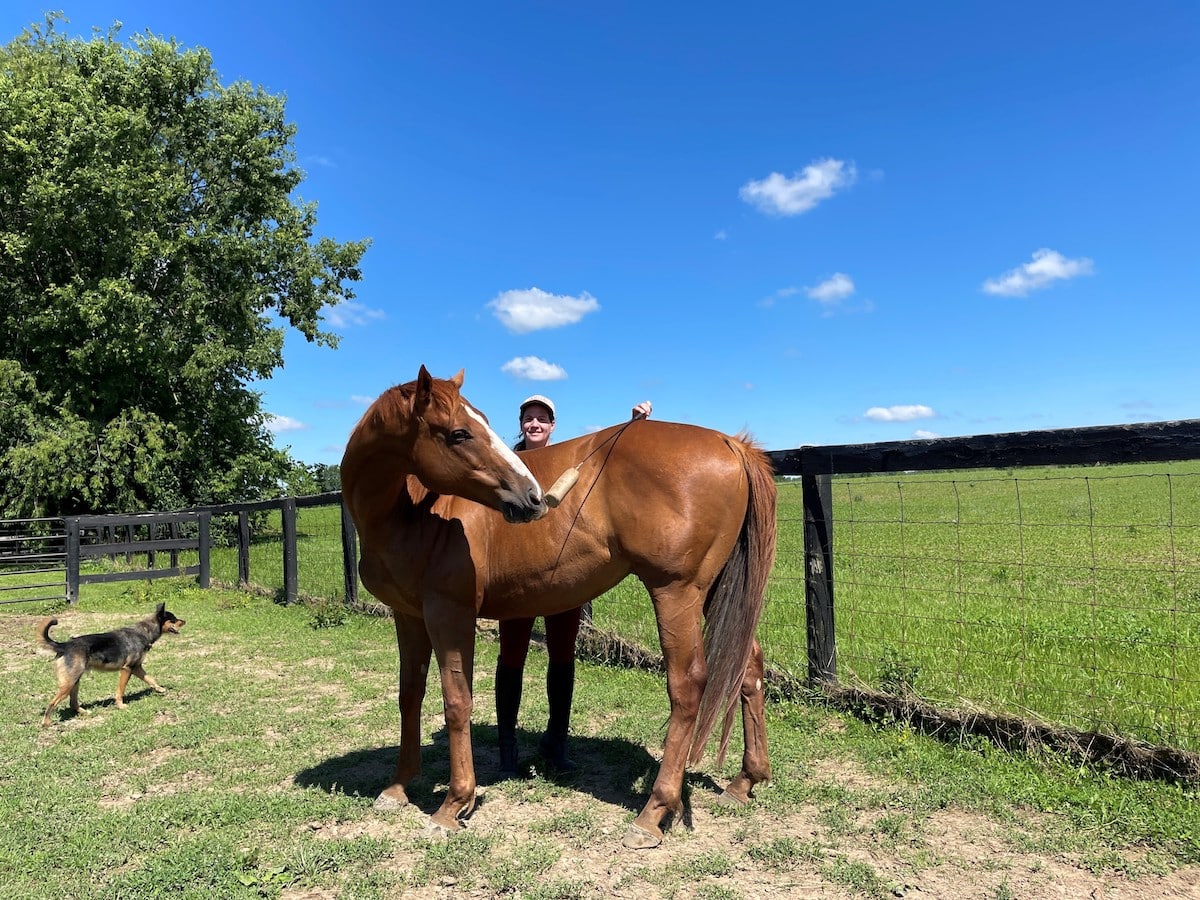
Standing stretches are one of several ground exercises Kara Musgrave uses to build a horse’s core abdominal muscles. Courtesy Kara Musgrave
Besides being bred to race, all off-track Thoroughbreds in their second careers have something in common: Core strength is critical to their soundness, no matter the riding discipline.
But when horses are as athletic, willing and eager as many OTTBs are to get to work, it can be tempting to skip ahead, progressing through levels without putting in the effort that will help them train optimally and even resist injuries. This applies as much to veteran OTTB sport horses coming back after an injury or extended vacation as it does to recently retired racers.
We spoke with a veterinarian who specializes in sports medicine and with two trainers who emphasize strong cores and correct biomechanics in their methods about what you need to know to build strength and agility and, thus, versatility in your OTTB, while supporting soundness.
Abs Like a Racehorse
Thoroughbreds right off the track are not the blank slates, muscle-wise, that riders and trainers might believe. Typically, they are super fit, strong and well-conditioned to propel forward with bursts of speed and sustain pace over distance. It’s when they have time off that they need a foundational core-strength reset so they can perform well in their new jobs.
Selma Latif, Dr. med. vet., Dipl. ACVSMR, IVCA, CERP, is assistant at the University of Zurich’s equine sports medicine department, in Switzerland, where she sees a variety of equine patients, including OTTBs.
“One of the main problems I see in the transition phase of a very well-muscled, core-stabilized racehorse to a sport horse is when there is a longer phase of easy to no work — maybe because the horse doesn’t find his new owner very soon or the new owner wants to give him a break,” says Latif.
“In this phase the horse gets destabilized in terms of its capacity to carry a rider properly — with active trunk-supporting muscles — because of muscular inactivity and, so, is prone to suffer from preexisting degenerative diseases of the distal (lower) limbs.”
In other words, says Latif, the post-letdown horse no longer has the well-trained shock-absorbing system of the trunk to absorb the forces he generates in movement. Instead, they’re transmitted to the limbs, aggravating existing pathology — disease or damage — or causing destruction anew.
“Main problems of the distal limbs in this context are DJD (degenerative joint disease) of the fetlock, recurring tendon problems and hoof imbalances,” she adds. “Another problem area of a weak core is the back, where osseous pathology and muscle hypertonicity (increased passive stiffness or tightness) can lead to pain, which is the starting point of a vicious circle, since a horse in pain is not willing to use its body in a healthy and useful way.”
Latif emphasizes that riders and trainers must focus on reactivating and training trunk supporting muscles — including the shoulder girdle, multifidi and abdominals — to establish sustainable orthopedic health and long-term rideability.
“This may require a period of groundwork, longeing or training on a treadmill, in combination with core strengthening exercises in the standing horse,” she says.
Working on My Fitness
Kara Musgrave, a positive reinforcement horse trainer based in Lexington, Kentucky, uses groundwork primarily to begin building a horse’s core abdominal muscles. One of her favorite success stories is a chestnut OTTB named Rocco (Jockey Club name: Harvey [Curlin — Upcoming Story, Tale of the Cat]), who was coming back to work after a year off due to hoof abscesses and hindgut issues.
“It was challenging to build up his fitness after so much time off,” she says. “I could feel him going hollow under my weight because he lacked the core muscles to hold me up. I knew that I needed to find a way to build him back up before putting my entire weight on him.”
She began with lots of standing core work — carrot stretches, standing crunches (see page 30) and asking him to pick his legs up to improve his balance.
“I like to do a lot of stepping over obstacles at the walk, because if he slowly picks his legs up one at a time, he’s having to activate his back and his core muscles to do that. You can feel that doing this exercise as a human, too.”
Other useful ground exercises Musgrave applies:
■ Backing in hand. Besides building abdominal muscles, this aids the horse’s proprioception — awareness of where the limbs are in space.
■ Leading between poles that turn 90 degrees, forward and backward.
■ Walking over poles in irregular patterns (some a little offset from expected measured distance, some raised, some on the ground). “All those things make the horse think about their foot placement, and the best way to strengthen balance is to challenge balance.”
■ Standing on gym mats or balance pads designed for human athletic training. “Their bodies have to work and figure out how to stabilize,” she says. “I have tons of videos of my horses standing on mats, and they look like they’re just chilling, snoozing, but if you slow the video down and zoom in, you’ll see all these (spots where the abdominal muscles are) firing and activating.”
■ Teaching your horse to bend his body voluntarily. “You can do this by having them follow a target in a circle around the stall. The constraint is the space, which causes them to have to self-organize.”
■ Warming up. Do carrot stretches and hand-walk your horse to get his muscles moving under tack before groundwork and mounting.
Musgrave also teaches a version of the Spanish walk by asking her horses to touch a foam target or pool noodle with their forearms each step, with a bridge signal like a clicker. This helps horses build abdominal strength as they stretch their legs out farther and higher.
“Once they get good with that, I’m going to start adding weight,” she says, which she does with sandbags for a few sessions before eventually mounting. “Scaling it up in a gradual way and not going from nothing to entire-human-plus-saddle is going to produce much bigger, faster progress than doing groundwork with just a saddle and then one day seeing how they do with a rider.
“With Rocco what I would do is get on and ride an interval workout — a couple of minutes, hop off, walk, get back on,” she explains. “I could feel those moments when his back was starting to go hollow (and his head would go straight up), and I would hop off, helping him build back up slowly and meticulously.
“He went from being back sore and girthy and not generally wanting to be tacked or touched to being really well-muscled, athletic and willing,” she says.
Be sure to scale the work up in other ways, too, whether that’s adding more poles or raising the poles.
“A lot of the time we do the same activities over and over again,” says Musgrave, “but if you want to keep growing, you need to figure out a way to make it tougher. Can they do it on a hill? Maybe a steeper hill? Can they step over a big log that’s maybe just a little bit wider than a set of jump poles?”
Standing Crunches
Standing crunches involve the horse lifting the lumbosacral area of his back and tucking the pelvis, all by activating the abdominal muscles. Musgrave teaches this by backing the horse up to a wall and pairing a cue (for example, saying “lift,” as you give a hand signal) with and marking the correct movement using a well-timed bridge signal like a clicker and a treat. Eventually the horse responds to the cue when standing away from the wall, and she’ll ask him to crunch while standing on a hill, an athletic training balance pad and, eventually, a bridge obstacle on a fulcrum.
Take-Home Message
Your retired racehorse’s core has been trained before and can be trained again to perform his second career job optimally. Never rush, and always look for signs it’s time to pause or to scale up the work. Most importantly, consult your veterinarian about any former injuries or physical limitations your horse might have, and relay that information to your trainer or instructor before beginning your core work in earnest.
This article is part of a series that continues with under saddle work. Read the next installment here!

